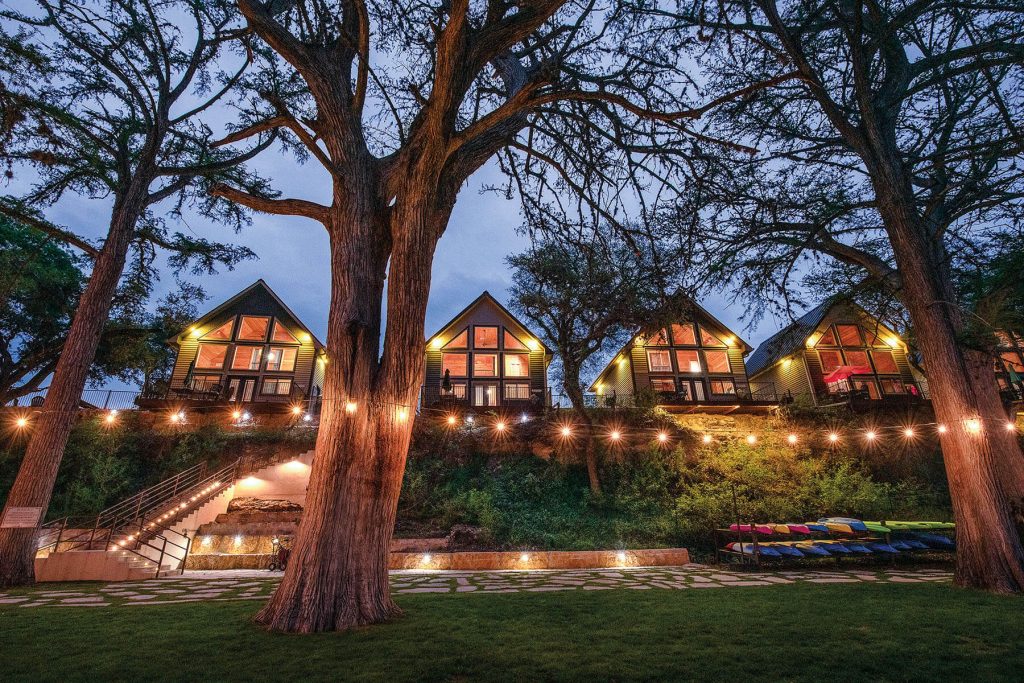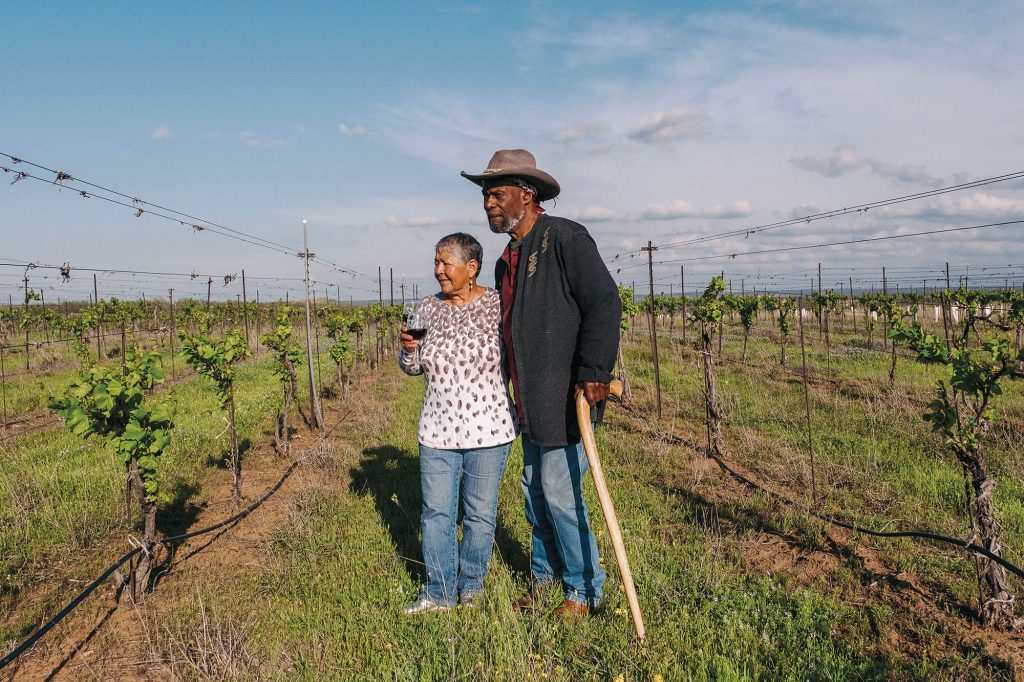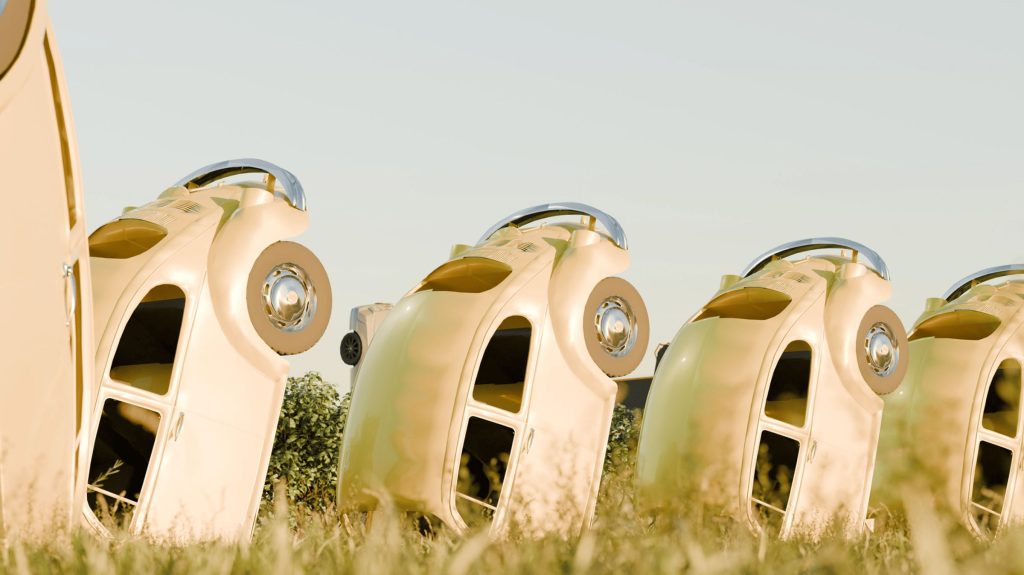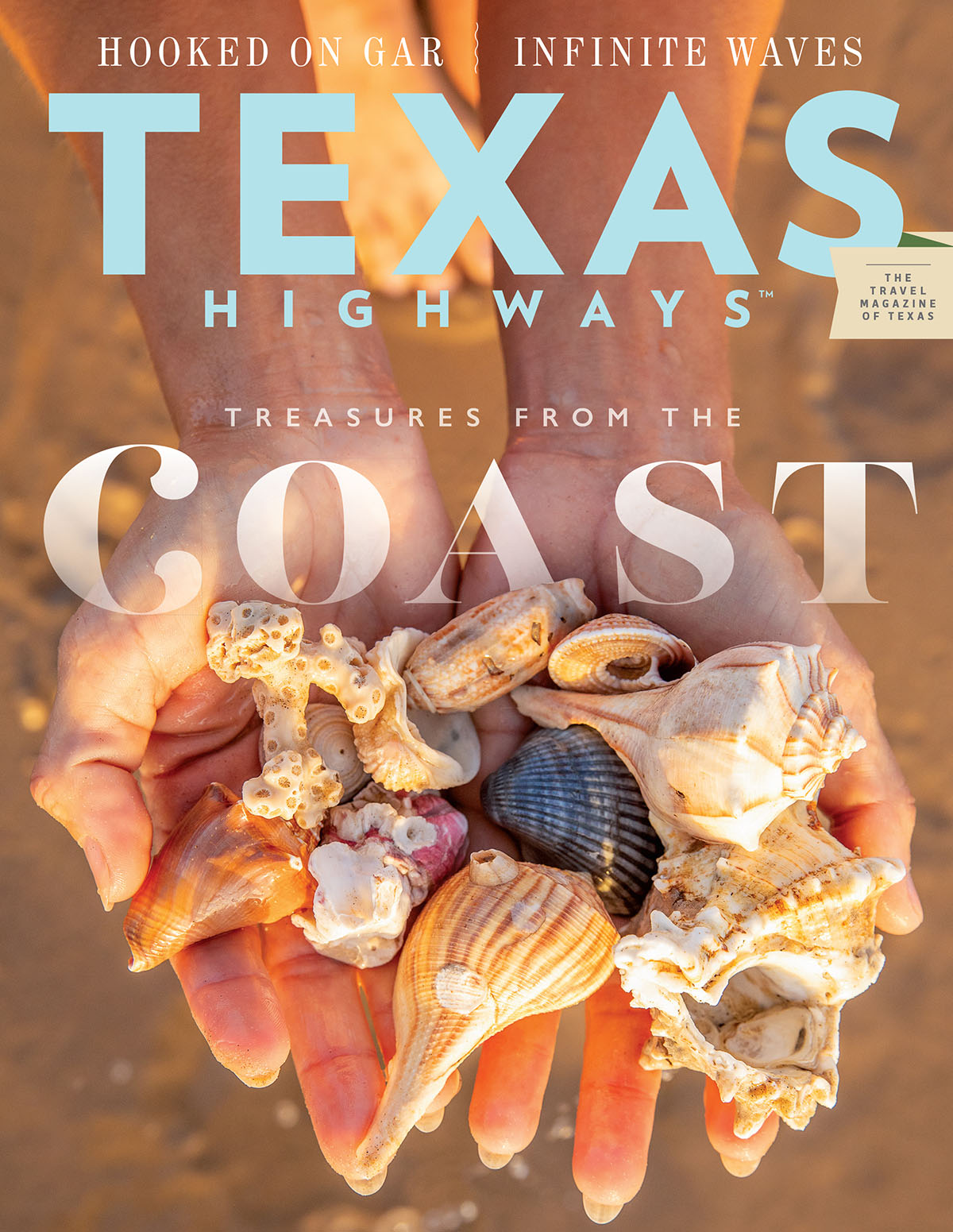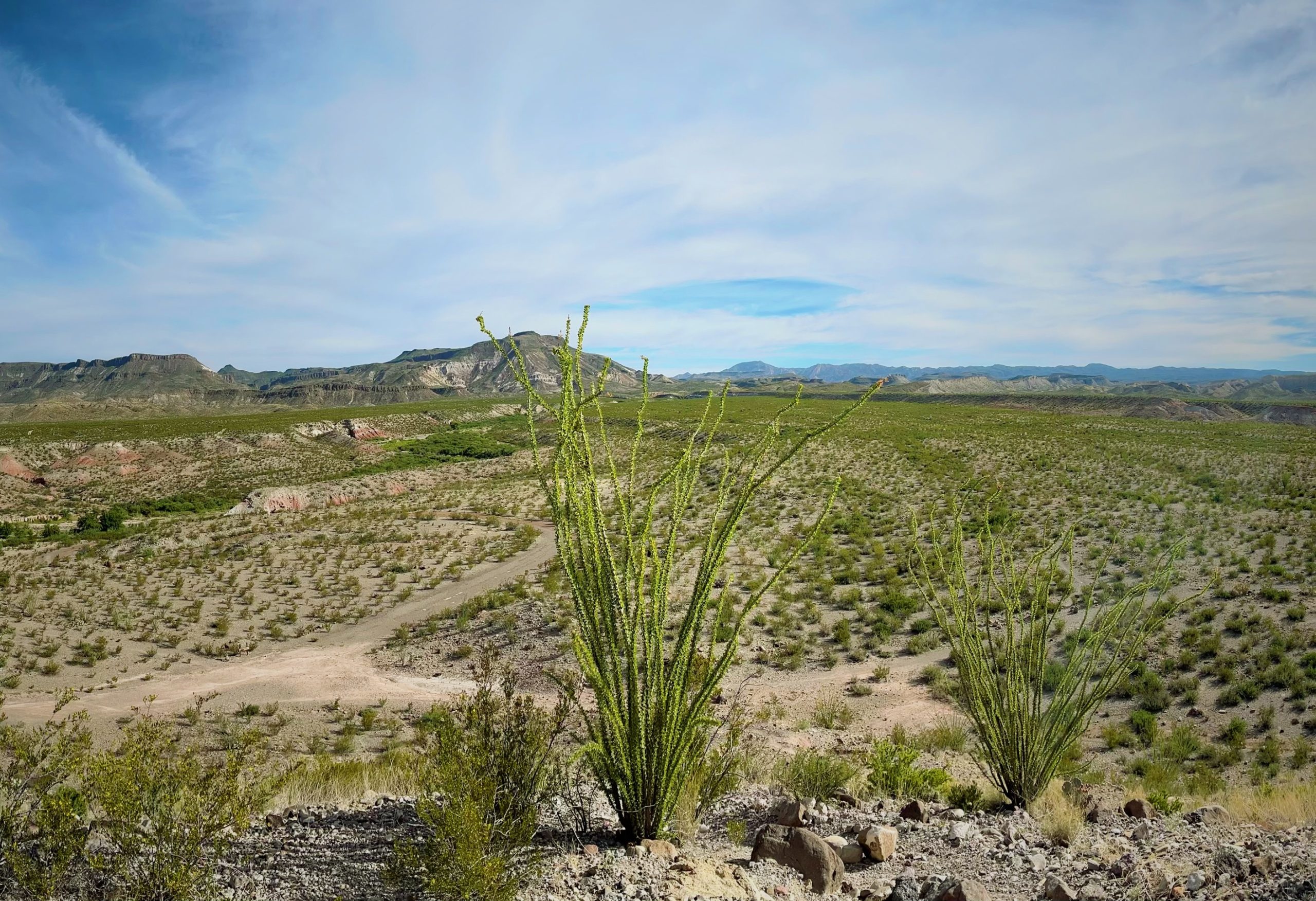
Jeff and Harper Hahn’s view of Big Bend Ranch State Park during their hike. Photo courtesy Harper Hahn
As Jeff Hahn wedged his way into the old mining shack, he hoped that there’d be something in there that might help him, something more than shade from the brutal Texas sun.
At first, all he found were a few long tables and benches. He looked around again, and this time noticed what he calls a miracle: two 1-liter bottles of water resting on a windowsill. Though coated in a layer of dust, the bottles, emblazoned with an H-E-B label, were still sealed.
That was the first of several “miracles” that Hahn says saved his life in the desert. Jeff, a 59-year-old marketing executive from Austin, was about eight hours into a hike that he had started with his 25-year-old daughter that morning. Jeff and Harper Hahn had intended to hike three or four miles in Big Bend Ranch State Park, but they had quickly gotten lost in the minimally marked desert, and then run out of water in the mid-June heat. One of the area superintendents at Big Bend Ranch, Laura Jennings, said the park felt like a “convection oven” around the time of the Hahns’ trip. The rescue report shows that the park was 107 degrees in the shade on the day the Hahns started their hike.
Take a Hike—Safely
Texas’ parks and outdoors spaces can be dangerous places. Here’s how to keep yourself safe, as recommended by Big Bend Ranch State Park’s complex superintendent Nathanael Gold, former Big Bend National Park ranger Colin McMechan, and state park police officer Laramy Estel of Palo Duro Canyon State Park.
Rangers say the most important part of a hike or backpacking trip is the preparation.
Pack lots of water. Bring more than you think you’ll need, and do your best to hydrate ahead of time, too.
Bring salty snacks or electrolytes. Even if you’re well-hydrated, you could run into trouble if your electrolytes get out of balance. McMechan says he prefers to pack electrolytes in powdered or tablet form, as opposed to already-mixed sports drinks.
Bring a map. Parks typically hand out paper maps at the gate, and you should take one. Estel also notes there are apps—including AllTrails and onX—that let you download sections of maps, which can then show your location even when you’re out of cell service.
Bring basic survival tools. To prepare for the unexpected, every hiker should carry a first aid kit, splinting supplies, a rope, a knife and a compass. And make sure you know how to use the compass, too.
Buy an emergency beacon. Emergency beacons can cost a few hundred dollars, but they can also save your life, by allowing you to send your location to rescuers even when you’re out of cell service range. “They’re not cheap, but if it’s a difference in life and death, there’s not really anything that’s too expensive,” Estel says.
State and national parks cope with heat incidents every year. Heat deaths in national parks appear to be on the rise, according to data from the National Park Service, and Texas parks—both state and national—saw at least six heat deaths this summer. Heat distress can affect hikers of all ages and skill levels.
And as Jeff and Harper hiked further into the desert, heat distress began to set in for Jeff. The worst were the leg cramps, which turned into full-body cramps. He could only walk a short distance before needing a break.
“There’s not a blade of grass. There’s no trees,” Jeff says. “You’re exposed, there’s no place to hide.”
With no cell service, and not knowing how far away the trailhead might be, the Hahns decided Harper should hike ahead and get help. They agreed Jeff would stay behind at a rocky outcropping and wait. But he didn’t just wait.
His legs seared, and the only thing that eased that pain was moving. Plus, he hoped he could close some of the distance between himself and help. In doing so, he broke a cardinal rule of being lost: stay put. (Jennings noted that people suffering from dehydration and heat distress often make decisions that they otherwise wouldn’t.)
Harper and state park superintendent Nathanael Gold headed back out on an ATV at about 7:30 p.m., according to the rescue report. By the time they made it back to the rocky outcropping, Jeff wasn’t there. And Harper had no idea where he could be.
By the time Gold and Harper got back to the outcropping, Jeff had already been at the shack several miles away for well over an hour, he estimates. After the sun set, Jeff left the shack and began walking again. It was a dark night, he said, with barely enough moonlight to see, and his body was weak. He dragged himself through the desert, repeating the same mantra over and over: “Clear head. Strong legs. Harper’s on the way.”
As Jeff plodded through the dark, one of his feet snagged on a rock. He fell, his hands out in front of him, fracturing one of his wrists. This was Jeff’s second miracle. He had fallen next to a large rock, with a pool of water collected on top. He used his CamelBak straw to drink from the pool, still lying facedown, unable to get up. As the night stretched on, Jeff lay where he had fallen, and watched the Milky Way move across the sky. When, at last, he tried to get up, it took him about 20 minutes to get upright, he says.
He trudged on as day broke. He had made it through the night.
Gold had spent the night assembling rescuers from across the region, while Harper waited in the hotel room, making calls to family and friends while anxiously waiting until morning. Rescuers included rangers from the Texas Parks and Wildlife Department, park police officers from Big Bend Ranch State Park, a plane and helicopters from the Texas Department of Public Safety, and more.
State park police officer Jacob Barton was called in from nearby Davis Mountains State Park. Even though he and the other rescuer he hiked with had brought an abundance of water, they ran out as they hiked—a first for Barton. “It was the hottest I have ever been,” Barton says. “My brain was baked.”
Barton says he and most of the rescuers were searching the area where Harper had left her father. At this point in the search, on day two, the rescuers thought they were probably searching for a body, particularly after a strikingly similar search two years ago, where a lost hiker was found dead.
Meanwhile, Jeff had stumbled upon his third miracle.
As the day grew hotter, he clambered up a steep hillside and into a small canyon and found a small stream. Beside the stream was a pool, filled with tadpoles. In addition to being dehydrated, Jeff was also hungry. Hungry enough to go “full Naked and Afraid,” he says. Hungry enough to take off his hat, dip it into the pool, scoop out a couple of tadpoles, and eat them.
Then, Hahn saw the plane in the distance. It took several passes, of the plane and then the helicopter, passes where Hahn thought that maybe they hadn’t seen him, maybe they’d leave without ever seeing him.
But then, he heard a voice in the distance. It was a rescuer, and he was calling Jeff’s name.
When Harper got back to the trailhead, where rescuers had brought her dad, she saw him sitting in a lawn chair, dirty and pale, but alive.
“My dad was just chilling like it was a soccer game,” she says. “He just looked like my dad.”
He may not have immediately looked like he’d spent more than 24 hours lost in the desert but, Harper says, he did smell like it. And when Jeff got to the hospital, doctors said he was worse off than he looked.
The leg and full-body cramps that had spurred Jeff to keep walking weren’t just heat cramps. His body had gone into rhabdomyolysis, a condition where the body’s muscles begin to break down, triggered by the extreme hiking conditions and exacerbated by the blood pressure medication he takes. It meant that Jeff’s kidneys were in danger— he was suffering from acute renal failure, according to his medical records—and he spent several days in the hospital.
Now, a few months later, Jeff is fully healed, aside from slightly limited mobility in the wrist that he broke.
Hahn calls the Big Bend State Park area “mystical,” and says he doesn’t want his story to deter others from hiking or venturing into parks. He hopes to make it back out to the park at some point, to replace the water bottles that he found in the old shack, the first of the miracles that saved his life.
“We’re going to turn ourselves into trail angels,” Hahn says. But this time, he says, he thinks he’ll take an ATV.
What to Do If Lost at a State Park
With limited cell service and sparse trail markers, some state parks are easy to get lost in—literally. Here are a few tips if you can’t find your way back.
Activate your emergency beacon. Especially if traveling alone, don’t hesitate to pull the alarm.
Tell people where you are ahead of time. Park rangers advise hikers to give a loved one a detailed itinerary of where you’re going to be, and when. That way, if you don’t come back from your hike at the right time, your loved one can call emergency responders and also give them information on your whereabouts.
Stay put. If you do end up lost, injured or otherwise unable to make it back to the trailhead, the rangers’ No. 1 piece of advice was not to move from your location. Once you’ve set off your beacon, or your loved one has alerted emergency responders that you’re missing, it’ll be much easier for rescuers to find you if you aren’t moving around.
